5 big benefits and 3 simple steps to aquarium water changes
Aquarium water changes, removing part of the water and replacing it with new water, should be done on a regular basis. Water changes not only clean the aquarium but also bring many benefits which are related to the health of the living organisms.
- 5 big benefits of regular aquarium water changes
- How often and how much should I change aquarium water?
- 3 steps to changing aquarium water
5 big benefits of regular aquarium water changes
1. Remove and dilute nitrate concentration
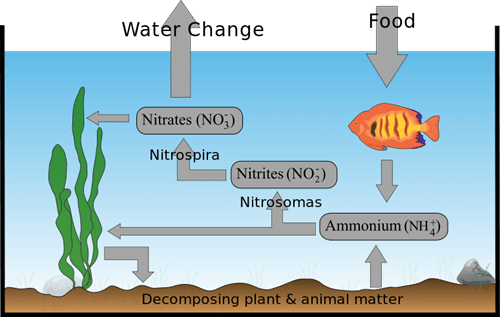
Aquarium nitrogen cycle
As you know, there are harmful ammonia and nitrite that are created in the tank by its various inhabitants, visible as well as invisible. They are finally degraded into less toxic nitrate by nitrifying bacteria as the last step in the nitrogen cycle.
Unlike either ammonia and nitrite, which are fleeting, the nitrate levels will build up over time. If left unchecked, they can concentrate to levels that are not healthy for the fish to live. The recommended concentration of nitrate should not exceed 50ppm for most freshwater aquariums and 25ppm for saltwater fish tanks (FOWLR).
The most important role of the partial water change is to dilute the nitrate concentration by drawing out water high in nitrate and replacing it with fresh water with little or no nitrate content.
2. Remove accumulated chemicals and compounds
Besides nitrate, there are other chemicals and compounds dissolved in the water, these concentrate over time and can cause problems with high enough concentration. Water changes pull them out and replace with fresh water without the dissolved content helps keep all the water characteristics even and balanced over time.
Misconception!
A water change is not the addition of new water to make up for evaporation.
The water level of an aquarium should be kept slightly over the bottom of the top rim of the aquarium. The top of the water will be hidden by the rim. This provides a living picture that is properly framed.
When the level drops to the point of being seen, the lost, evaporated water needs to be replaced. This is not the same as a partial water change.
In fact, since there are other chemicals and compounds dissolved in the water, these are left behind and can further concentrate. If the only maintenance that is done is to replace water as it evaporates – compounds will concentrate.
3. Replenish trace elements
Every creature in the aquarium need minerals and trace elements for their living activities. They get these substances from foods and the surrounding water. That means these substances can be exhausted if not replenished.
Luckily, for freshwater aquariums, you don’t need to dose calcium, magnesium, iodine, strontium, e.g. like saltwater reef aquariums. Just change the water and the new water will replenish all trace elements for the fish and plants.
4. Replenish alkalinity (KH – carbonate hardness)
Alkalinity is the measurement of bicarbonate (HCO3 -) and carbonate (CO3 2-) ions in the water. Alkalinity refers to the water’s ability to buffer out the effects of acids entering the system and being able to absorb them without any change in pH.
In the aquarium, the carbonate hardness of the water will drop over time due to the constant manufacture of acid within the aquarium due to various life processes such as decay. And pH can slowly overcome the buffering capacity and then drop over time. By changing the water, you add new carbonate ions to the aquarium that prevents this process.
5. Eliminate dirt, debris, and sludge build-up
The final reason to perform an aquarium water change is to eliminate, as much as possible, the dirt and debris that gets trapped in the gravel. This can add pollution to the aquarium if left undisturbed.
The very best way to remove water from an aquarium is to use a gravel cleaner. A gravel cleaner will draw up wastes and particles that fell into the substrate before the filter was able to remove them. You will be surprised at how much collects in the gravel between regular siphoning periods.
Use the water that has been removed to water houseplants and in the garden to give the plants some of the best natural fertilizer possible. This is a great side-benefit to regular tank maintenance, use it and you will love it.
How often and how much should I change aquarium water?
Never remove and replace the entire contents of the tank. When a tank is stripped down and the water fully replaced, the water conditions change dramatically in almost every measurement. The fish are completely stressed from the radical shift of their living parameters. The beneficial bacteria that have been carefully cultivated are often killed or washed away, as well.
No matter what the original problem may have been that caused the need for a complete water change, this is usually much worse for the fish.
A partial water change ensures that the water is not radically different from what the fish are accustomed to. There should be a large enough change to keep most characteristics steady and safe.
I suggest about 15-20% of the water removed and replaced every week. Most people will decide on a bi-weekly maintenance schedule. In this case, since the water is being removed only once every two weeks, remove and replace 30% of the aquarium volume.
However, there is no specific number, it depends on the bio-load of your tank. Your goal is to take the nitrate concentration under control. As previously mentioned, the recommended concentration of nitrate should not exceed 50ppm for most freshwater aquariums (30ppm for planted tanks) and 25ppm for saltwater fish tanks (FOWLR). By weekly testing the nitrate, you can know the best schedule of water changes for your tank.
I prefer never to go over a 20% aquarium water change. If there is illness, or the aquarium is under heavy waste distress, I will take the first 20% and then wait a day before doing the same ritual all over again. It is often much better to spread the huge water replenishment task over a series of days rather than shocking the fish with sudden and dramatic massive replacement.
3 steps to changing aquarium water
1. Cleaning the inside glass
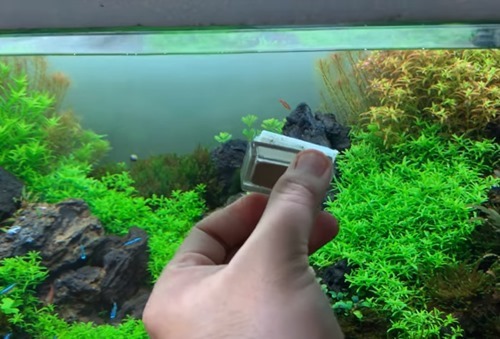
Cleaning the inside glass with an algae magnet
The inside glass should be scraped of algae spots and protein build-ups on a regular basis. The best time is during a standard water change to make sure as much debris as possible can be removed when the water is siphoned off.
Always use a clean pad or scraper to clean the glass. Never use a cleaning pad that has had contact with soap. It will wreak havoc in the aquarium if soaps get in.
If you use a pad or some tool that allows contact of your hand with the water when aquarium glass cleaning, be sure you rinse off your hands and arms. You should eliminate any lotions or other creams that might otherwise be allowed to enter the system. The less pollution you add, the better.
There are a number of different tools available for aquarium glass cleaning: razor blade scraper, plastic blade scraper, sponge on a stick, cleaning pad, algae magnet, e.g. For acrylic tanks, you should use a soft cleaning pad #ad to prevent scratches.
Algae magnets are best for people who are cleaning the glass often, ensuring that hard deposits never get a chance to gain a foothold. They keep your hands dry; however, the aquarium glass cleaning ability is directly the result of the strength of the magnets. Be sure to purchase a magnet that has been designed to work with the thickness of the aquarium glass.
When the algae is very hard and firmly attached, in many cases the only way to remove it is to use a razor blade scraper #ad or strong pressure and effort with an algae pad.
 Hygger 6 in 1 Aquarium Cleaning Tool Kit #ad
Hygger 6 in 1 Aquarium Cleaning Tool Kit #ad
Whenever you are cleaning the glass, be especially careful near the bottom of the tank, close to the substrate. Standard small aquarium gravel often has many sharp facets. It is hard enough that it will scratch the glass when trapped between the pad and the glass.
Always ensure the only thing touching the glass is the algae pad or scraper, and that no gravel has been accidentally trapped there to scratch as it is moved around the glass surface.
2. Aquarium gravel cleaning and substrate maintenance
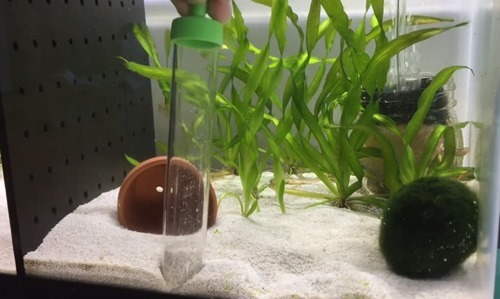
Aquarium gravel cleaning is very important for the well-being of the aquarium since it is here that quite a bit of waste becomes trapped and can rot. The main tool used to remove solids and debris is the gravel cleaner.
The gravel cleaner is most often a siphon tube attached to a rigid tube. Once the siphon is started, most often by a few flicks of the wrist to get it flowing, the rigid end of the tube is driven into the gravel substrate.
The rigid siphon tube is run through the gravel layer, usually in a regular pattern. The siphon flow draws the dirt and debris up and out with the water stream.
The ideal flow is such that the gravel particles are drawn part-way up into the rigid tube and then fall back to the bottom. The trapped debris hidden in the gravel is drawn by the stream up and into the bucket to be discarded.
If the water change is not large enough to cover the entire bottom, set a pattern for the cleaning and resume where you left off when the full change percentage was reached.
The water that is removed is the dirtiest in the aquarium. In most cases, so much dirt will be removed that the water actually turns almost black. This water is full of nutrients for terrestrial plants and should be discarded onto houseplants or out in the garden to help them all grow with true fish fertilizer.
You can also use the removed water to rinse your filter media. This water is chlorine-free and safe for helpful bacteria, which colonizing on the surface of the filter media. You can also clean your filter media with new clean water if you want but ensure that the water is already dechlorinated with a good water conditioner.
3. Refill the tank with warmed and dechlorinated water
Finally, you need to prepare new water to refill the tank. You need a clean bucket for preparing new water for changing. Ensure the final water you add to your aquarium is safe for the living creatures.
You can use dechlorinated tap water or deionized water (RO/DI water).
If tap water is used, ensure to treat it with a water conditioner/de-chlorinator to remove any chlorine or chloramine. Some good water conditioners like API #ad also deal with heavy metals in the water that may harm the fish and invertebrates in the aquarium.
If your tap water is not suitable for keeping fish or just not suit the fish types you have in your aquarium, using RO/DI water is the safest and easiest way to achieve your desired water. Just remineralize the water #ad and adjust the pH with commercial products to get the best water for your fish.
The new changing water should be warmed to the aquarium temperature before you pour it into the tank. Using an extra heater for the water mixing bucket is strongly recommended. I want to be careful to avoid shocking the fish with either a difference in the temperature or too great a variation in characteristics between old and new water.

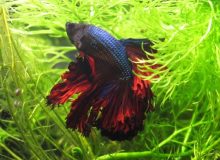
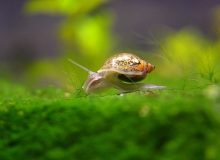
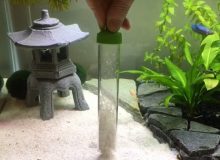
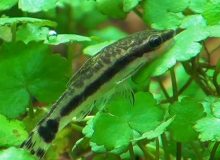
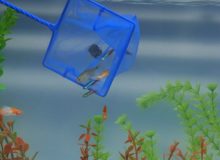
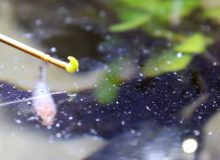
Hi,
Portland water seems to always have 0.5ppm ammonia when I test it. Do you know if it ever gets lower?
I mix PRIME in my water buckets when i do water changes from my tap water at home. Any recommendations for using tap water for water changes?
I have a 45 gallon tank and 5 gallon. Keeping fish for a year now.
Thanks Lonny
PS discovered this website last night, and love it. I also ordered a tank light from your site on Amazon.
1. I don’t know because I don’t live in Portland.
2. You do the right way anyone do for water changes. The water conditioner will deal with any residual ammonia, nitrite, and heavy metals in the water.
Nice to know you enjoy my site.